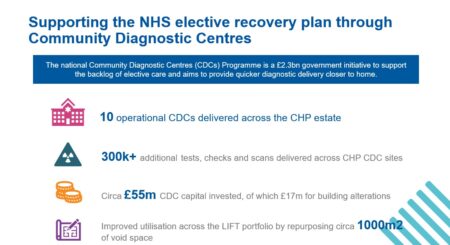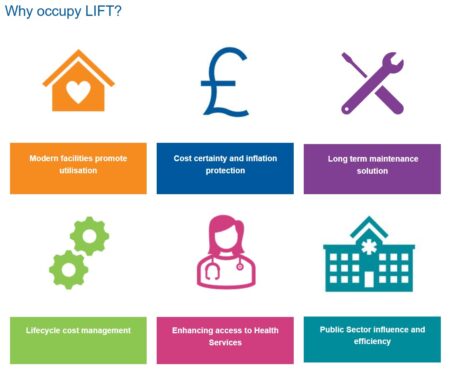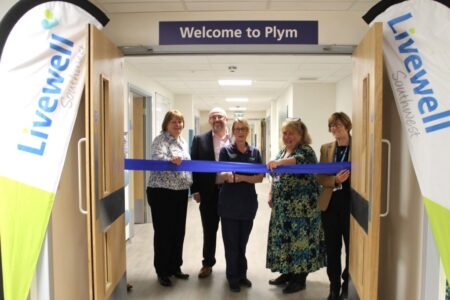Key priorities for NHS estates chiefs
In this article, Community Health Partnership (CHP) chief executive, Wendy Farrington-Chadd, considers the key priorities and themes that will shape its work across the NHS estate during 2025

Wendy Farrington-Chadd
About CHP
Community Health Partnerships (CHP) is a Department of Health and Social Care-owned company.
Incorporated in 2001 it aimed to improve NHS community-based health and social care estates through public private partnerships established through the NHS Local Improvement Finance Trust (LIFT) programme.
Through these joint ventures, and working on behalf of the NHS, CHP designed, built, financed, and now operates a portfolio of over 300 properties.
In 2013 CHP was given head tenant responsibilities for 308 properties passed over from the former Primary Care Trusts (PCT).
And it currently leases space to over 1,300 health and care providers who support tens of millions of patients and service users.
CHP has a unique set of skills and experience in primary and community care infrastructure development, property management and investment portfolio management and offices in Manchester, London and Birmingham.
It properties comprise of 5% of the NHS estate portfolio.
The 10 Year Health Plan
The Government will publish its 10 Year Health Plan this year.
This will set the direction of travel for the NHS for the long term, driving NHS reforms and delivery of its Health Mission – Building an NHS fit for the future.
The Darzi Review published last September diagnosed a health service that was ‘broken but that its vital signs were strong’.
And the resulting focus in on three NHS shifts: hospital to community, analogue to digital, and treatment to prevention.
The concept of a ‘Neighbourhood Health Service’ will be key as healthcare delivery becomes more localised and community focused.

The role of infrastructure and the estate
It is widely acknowledged that the NHS estate is fundamental to healthcare delivery, and in particular, the community-based estate will play a crucial role in enabling the delivery of a ‘Neighbourhood Health Service’.
While the shift to digital and adoption of technology will change where people receive their care, with potentially more appointments and contacts becoming virtual, the need for physical health infrastructure in local communities remains.
There will also be a shift from hospital-based activity into local neighbourhoods; this continues a trend from the Community Diagnostic Centres (CDCs) which are now supporting outpatient and diagnostic services at scale.
Local capacity can help acute sites focus on more-complex interventions, promoting local services in communities supported by primary care.
Utilisation and optimisation
With constraints on public capital and public finances, making the most of existing core assets is key.
Integrated Care Boards have been asked to focus on delivering a Neighbourhood Health Service and will need to consider how infrastructure is used strategically and to view the NHS estate and its utilisation and optimisation holistically.
CHP is already driving utilisation of the LIFT core assets, working with NHS partners to ensure their optimal use.
But, as some of the best-quality community-based infrastructure available to the NHS, there is much more we can do to repurpose and adapt space to support new ways of working or models of care.
This requires bold and informed decisions, imagination, and changes in mindsets and behaviours to deliver within the parameters of finite resources.

Delivery and productivity
Given the drive for NHS reform and greater productivity, there is scope and opportunity to invest in capital projects that support delivery of more care in the community, supporting the development of Neighbourhood Health Services.
Last year CHP developed its Productivity Acceleration in the Community Estate (PACE) Programme which helps us focus on the bigger opportunities to repurpose and adapt space to drive up utilisation and optimisation across the LIFT portfolio for improved patient care.
We work with ICBs to look at all opportunities to optimise the use of the LIFT estate – for instance expanding community diagnostics – applying lessons from our successful Community Diagnostic Centre Programme.
Value for money
Making best use of existing assets presents better value for money.
We recently commissioned a report from PWC to compare the relative cost of the LIFT estate to the broader NHS and commercial estate.
The report found that the LIFT estate presents value for money and other significant benefits to the NHS, its patients and staff.
Increasing utilisation of the LIFT buildings as core health assets will enable the NHS to deliver the Government’s mission, drive up NHS productivity, and transform care delivery while achieving greater value.

Partnership working was critical to the deliver of the Mount Gould Health Campus in Plymouth
Partnership and collaboration
Partnership working is fundamental to delivering the NHS reforms and is at the heart of the LIFT model.
We recognise that we need to support the NHS make bold and informed decisions about the use of core assets through the provision of information and data.
We have been sharing this through our system offer packs and in supporting local strategic estate planning discussions.
We know that the LIFT portfolio is one part of a bigger picture, and when we work closely with ICBs, NHSE regional estates teams, NHS Property Services, and our LIFT partners we can unlock estate challenges and find solutions that support local health and care systems to deliver on their ambitions for their communities.
Our partnership working at Mount Gould Health Campus in Plymouth, and our investment and repurposing of the Local Care Centre for neuro-rehabilitation services is a great example of this.
2025 will be a busy year, and we look forward to continuing our support to the NHS locally in the development of neighbourhood services through the LIFT assets.
